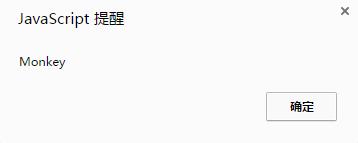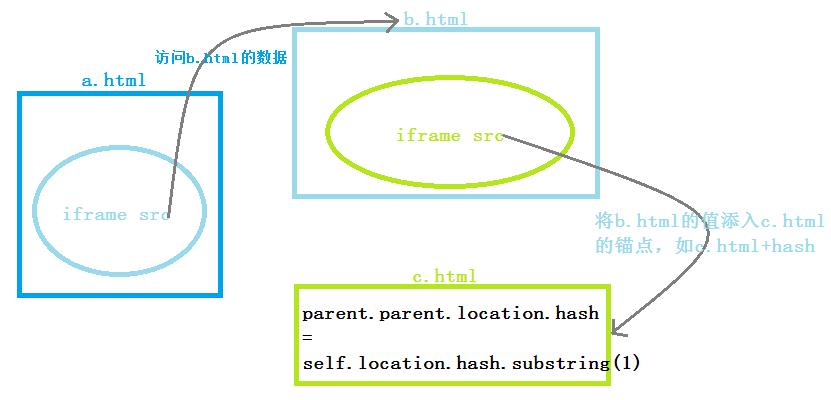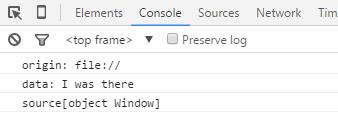iframe跨域+
Posted
tags:
篇首语:本文由小常识网(cha138.com)小编为大家整理,主要介绍了iframe跨域+相关的知识,希望对你有一定的参考价值。
script、image、iframe的src都不受同源策略的影响。所以我们可以借助这一特点,实现跨域。如前面所介绍的JSONP跨域,以及灯标(Beacons)。
该篇随笔主要阐述iframe结合一些技术,实现跨域请求。
1、iframe+window.name;
2、iframe+location.hash;
3、iframe+window.postMessage.
另,在最后赋予“灯标”技术阐述。
| 一、iframe + window.name实现跨域 |
window对象有个name属性,该属性有个牛逼的地方就是:在同一个窗口中,我不管你页面怎么变,我window.name的值是一直存在的,在同一个窗口任意读写,并且支持非常长的name值(2MB)。
有点含糊?
我们写个demo看看。
假设我有个页面a.html,当页面加载完成后,我将window.name赋值’Monkey’,在3秒后跳转到另一页面b.html,并在这个b.html中alert一下window.name,看看结果如何。
a.html代码如下:
<!DOCTYPE html> <head> <title>window.name</title> <meta http-equiv="Content-Type" content="text/html; charset=utf-8"/> </head> <body> <script> window.name = \'Monkey\'; setTimeout(function(){ window.location = \'b.html\'; },3000); </script> </body> </html>
b.html代码如下:
<!DOCTYPE html> <head> <title>window.name</title> <meta http-equiv="Content-Type" content="text/html; charset=utf-8"/> </head> <body> <script> alert(window.name); </script> </body> </html>
运行a.html代码,等待3秒后,得如下结果:

看来,只要在同一个窗口,window.name就是可读写的,如,前一个页面设置了这个属性,后一个页面就可以读取它。
注:window.name传输技术,原本是用于解决cookie的一些劣势(每个域名4*20KB的限制、数据只能是字符串、设置和获取cookie语法的复杂等等)而发明,后来才强化了window.name传输,用来解决跨域数据传输问题。
假设,当我在一个页面a中想跨域访问另一个不在同一域中b的数据时,怎么利用window.name呢?
显然,我们不能像上面那样,将a页面window.location重定向为b,这样我岂不是当前页面已经不再了。所以我们可以借助于iframe标签来达到这一目的(因为iframe的src不受同源策略影响,所以可以跨域访问资源)。
思路:
(1)、在a.html中嵌入iframe,将所需要的文档b.html加载进来,且b.html利用window.name传入a.html想要获取的数据;
(2)、iframe在得到b.html的内容后,必须将src变为a.html的同源域,因为同源策略是会阻止非同源的frame访问name属性值,最后a.html通过iframe.contentWindow.name,获取b.html里window.name的值,从而实现跨域获得数据。
demo如下:

<!DOCTYPE html> <head> <title>a.html</title> <meta http-equiv="Content-Type" content="text/html; charset=utf-8"/> </head> <body> <script> /* addIframeTag:动态创建iframe,通过src获得相应文档 Param: src -->动态给创建iframe的src赋值 */ function addIframeTag(src){ //在loadFn函数中,用于判断iframe加载情况 var state = 0; //创建iframe var iframe = document.createElement(\'iframe\'); //loadFn:跨域获取数据,如b.html var loadFn = function(){ if (state === 1) { //获取window.name数据 var data = iframe.contentWindow.name; //相关操作,如alert获取的数据 alert(data); //清除动态创建的iframe iframe.contentWindow.document.write(\'\'); iframe.contentWindow.close(); document.body.removeChild(iframe); } else if (state === 0) { state = 1; // 将src变为a.html的同源域 iframe.src = "a.html"; } }; //给创建的iframe赋予指定的src值 iframe.src = src; //当iframe加载完文件后,触发onload事件 if (iframe.attachEvent) { iframe.attachEvent(\'onload\', loadFn); } else { iframe.onload = loadFn; } //隐藏iframe iframe.style.display = \'none\'; //将创建的iframe加入body中 document.body.appendChild(iframe); }; window.onload = function(){ addIframeTag(\'b.html\'); }; </script> </body> </html>

<!DOCTYPE html> <head> <title>b.html</title> <meta http-equiv="Content-Type" content="text/html; charset=utf-8"/> </head> <body> <script> window.name = \'Monkey\'; </script> </body> </html>
| 二、iframe + location.hash实现跨域 |
location.hash简而言之就是锚点,如127.0.0.1#monkey中的#monkey就是锚点。借用大额的一个例子,具体感受下锚点:here。
大家点击了上面的例子,会发现点击锚点后location.hash改变了,但却没有导致页面刷新。
So,我们就可以借助这一特性,实现数据传递。 但,因为我是借助于location.hash来实现数据传递,所以缺点也很明显:数据是直接暴露在URL中,且传递的数据容量有限。
那么,我们怎么通过location.hash来实现跨域访问数据呢?
假设:a.html想跨域访问b.html中的数据
思路:因为改变a.html的location.hash值不会刷新页面,所以我们可以借助iframe去访问b.html(因为iframe的src不受同源策略影响,所以可以跨域访问资源),然后在iframe中动态改变它父窗口a.html中的location.hash值。但是,个别浏览器不允许非同源的窗口修改parent.location.hash的值,所以我们还需要借助一个代理,在iframe获得b.html后,再在iframe里嵌套一个与a.html同源的html,如c.html,并通过c.html中的parent.parent.location.hash改变a.html中的location.hash值,从而达到跨域获取数据。

抛砖引玉,我的具体实现如下:
注:由于我是在本地跑的程序,所以我将c.html 直接换成a.html,并加入锚点判断,只是为了体验一把iframe+location.hash的跨域。

<!DOCTYPE html> <head> <title>a.html</title> <meta http-equiv="Content-Type" content="text/html; charset=utf-8"/> </head> <body> <script> function startRequest(){ //获得a.html的锚点 var _hash = location.hash ? location.hash.substring(1):\'\'; //如果锚点是b.html中的代理ifrmae传来的,则赋值,如somedata if(_hash === \'proxy\'){ parent.parent.location.hash = \'somedata\'; return; } else{ //创建一个iframe var ifr = document.createElement(\'iframe\'); ifr.style.display = \'none\'; //想b.html获取信息 ifr.src = \'b.html#paramdo\'; document.body.appendChild(ifr); //获得b.html的数据 setInterval(function(){ try{ var data = location.hash ? location.hash.substring(1):\'\'; if(console.log){ console.log(\'Now data is \'+ data); } }catch(e){ console.log(e); } },2000); } }; startRequest(); </script> </body> </html>

<!DOCTYPE html> <head> <title>b.html</title> <meta http-equiv="Content-Type" content="text/html; charset=utf-8"/> </head> <body> <script> //如果发现传过来的location.hash是#paramdo,做callBack操作 if(location.hash === \'#paramdo\'){ callBack(); } function callBack(){ try{ parent.location.hash = \'somedata\'; }catch(e){ // ie、chrome的安全机制无法修改parent.location.hash, // 所以要利用一个代理iframe,src与a.html同源 var ifrproxy = document.createElement(\'iframe\'); ifrproxy.style.display = \'none\'; //这里我指向a.html只是为了模拟同源 ifrproxy.src=\'a.html#proxy\'; document.body.appendChild(ifrproxy); } } </script> </body> </html>
| 三、iframe + window.postMessage实现跨域 |
HTML5引入了一个跨域文档API(Cross-document messaging),这个API为window对象,新增了个window.postMessage方法,允许跨窗口通信,且不必同源。
语法如下:
otherwindow.postMessage(message, targetOrigin);
(1)、otherwindow:对接收信息页面的window引用,可以是页面中iframe的contentWindow属性;window.open返回值;通过name或下标从window.frames取到的值。
(2)、message:要发送的数据,string类型。
(3)、targetOrigin:用于接收消息的窗口的源(origin),即“协议 + 域名 + 端口”。也可以设为*,表示不限制域名,向所有窗口发送。
postMessage是向窗口发送信息,当然相应窗口得接收信息咯。
怎么接收信息呢?
通过message事件,监听对方的信息。一旦有postMessage传送过来的信息就可以做相应处理了。
如下:
Window.addEventListener(‘message’,function(e){console.log(e.data);},false);
且message中的e(即event对象),通过三属性:
(1)、event.source:发送消息的窗口对象;
(2)、event.origin:发送消息窗口的源(协议+主机+端口号);
(3)、event.data:发送的消息内容。
抛砖迎玉Demo(a.html与b.html通信)如下:

<!DOCTYPE html> <head> <title>a.html</title> <meta http-equiv="Content-Type" content="text/html; charset=utf-8"/> </head> <body> <iframe id="ifr" src=\'b.html\'></iframe> <script> window.onload = function(){ var ifr = document.getElementById(\'ifr\'); ifr.contentWindow.postMessage(\'I was there\',\'/\'); }; </script> </body> </html>

<!DOCTYPE html> <head> <title>b.html</title> <meta http-equiv="Content-Type" content="text/html; charset=utf-8"/> </head> <body> <script> window.addEventListener(\'message\', function(event){ console.log(\'origin: \'+event.origin); console.log(\'data: \'+event.data); console.log(\'source\'+event.source); }); </script> </body> </html>
运行上述a.html代码,得下:

| 四、拓展--灯标 |
此技术与动态iframe标签插入非常类似,用javascript创建一个新的Image对象,将src设置为服务器上一个脚本文件的URL。此URL包含我们打算通过GET格式传回的键值对数据。
注意并没有创建img元素或者将它们插入到DOM中。
如下:
var url = \'/status_tracker.php\'; var params = [ \'step = 2\', \'time = 1465141496244\' ]; (new Image()).src = url + \'?\' + params.join(\'&\');
服务器取得此数据并保存下来,而不必向客户端返回什么,因此没有实际的图像显示。这是将信息发回服务器最有效的方法。其开销很小,而且任何服务器端错误都不会影响客户端。
简单的图像灯标意味着你所能做的受到限制。你不能发送POST数据,所以你被URL长度限制在一个相当小的字符数量上。你可以用非常有限的方法接收返回数据。可以监听Image对象的load事件,它可以告诉你服务器端是否成功接收了数据,你还可以检查服务器返回图片的宽度和高度(如果返回了一张图片)并用这些数字通知你服务器的状态。例如,宽度为1表示‘成功’,2表示‘重试’。
如果你不需要为此响应返回数据,那么你应当发送一个204 No Content响应代码,无消息正文。它将阻止客服端继续等待永远不会到来的消息体:
var url = \'/status_tracker.php\'; var params = [ \'step = 2\', \'time = 1465141496244\' ]; var beacon = new Image(); beacon.src = url + \'?\' + params.join(\'&\'); beacon.onload = function(){ if(this.width == 1){ //Success }else if(this.width == 2){ //Failure;create another beacon and try again. } } beacon.onerror = function(){ //Error;wait a bit, then create another beacon and try again. }
灯标是向服务器回送数据最快和最有效的方法。服务器根本不需要发回任何响应正文,所以你不必担心客户端下载数据。唯一的缺点是接收到的响应类型是受限的。如果你需要向客户端返回大量数据,那么使用XHR。如果你只关心将数据发送到服务端(可能需要极少的回复),那么使用图像灯标。
| 五、参考文献 |
[1]、大额
[2]、无双
[3]、RainMan
[4]、MDN
[5]、阮一峰
以上是关于iframe跨域+的主要内容,如果未能解决你的问题,请参考以下文章
